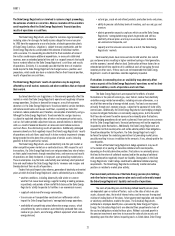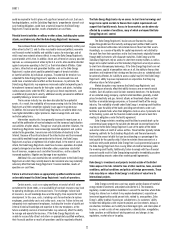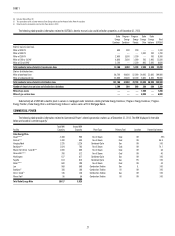Duke Energy 2012 Annual Report Download - page 42
Download and view the complete annual report
Please find page 42 of the 2012 Duke Energy annual report below. You can navigate through the pages in the report by either clicking on the pages listed below, or by using the keyword search tool below to find specific information within the annual report.
PART I
22
could be required to fund its plans with signifi cant amounts of cash. Such cash
funding obligations, and the Subsidiary Registrants’ proportionate share of such
cash funding obligations, could have a material impact on the Duke Energy
Registrants’ fi nancial position, results of operations or cash fl ows.
Potential terrorist activities or military or other actions, including cyber system
attacks, could adversely affect the Duke Energy Registrants’ businesses.
The continued threat of terrorism and the impact of retaliatory military and
other action by the U.S. and its allies may lead to increased political, economic
and fi nancial market instability and volatility in prices for natural gas and oil
which may have material adverse affects in ways the Duke Energy Registrants
cannot predict at this time. In addition, future acts of terrorism and any possible
reprisals as a consequence of action by the U.S. and its allies could be directed
against companies operating in the U.S. or their international affi liates. Cyber
systems, infrastructure and generation facilities such as the Duke Energy
Registrants’ nuclear plants could be potential targets of terrorist activities
or harmful activities by individuals or groups. The potential for terrorism has
subjected the Duke Energy Registrants’ operations to increased risks and
could have a material adverse effect on their businesses. In particular, the
Duke Energy Registrants may experience increased capital and operating costs
to implement increased security for their cyber systems and plants, including
nuclear power plants under the NRC’s design basis threat requirements, such
as additional physical plant security, additional security personnel or additional
capability following a terrorist incident.
The insurance industry has also been disrupted by these potential
events. As a result, the availability of insurance covering risks the Duke Energy
Registrants and their competitors typically insure against may decrease.
In addition, the insurance the Duke Energy Registrants are able to obtain may
have higher deductibles, higher premiums, lower coverage limits and more
restrictive policy terms.
Information security risks have generally increased in recent years as a
result of the proliferation of new technologies and the increased sophistication
and activities of cyber attacks. Through our smart grid and other initiatives, the
Duke Energy Registrants have increasingly connected equipment and systems
related to the generation, transmission and distribution of electricity to the
Internet. Because of the critical nature of the infrastructure and the increased
accessibility enabled through connection to the Internet, the Duke Energy
Registrants may face a heightened risk of cyber attack. In the event of such an
attack, the Duke Energy Registrants could have business operations disrupted,
property damaged and customer information stolen; experience substantial
loss of revenues, response costs and other fi nancial loss; and be subject to
increased regulation, litigation and damage to our reputation.
Additional risks and uncertainties not currently known to the Duke Energy
Registrants or which they currently deem to be immaterial also may materially
adversely affect the Duke Energy Registrants’ fi nancial condition, results of
operations or cash fl ows.
Failure to attract and retain an appropriately qualifi ed workforce could
unfavorably impact the Duke Energy Registrants’ results of operations.
Certain events, such as an aging workforce, mismatch of skill set or
complement to future needs, or unavailability of contract resources may lead
to operating challenges and increased costs. The challenges include lack
of resources, loss of knowledge base and the lengthy time required for skill
development. In this case, costs, including costs for contractors to replace
employees, productivity costs and safety costs, may rise. Failure to hire and
adequately train replacement employees, including the transfer of signifi cant
internal historical knowledge and expertise to the new employees, or the
future availability and cost of contract labor may adversely affect the ability
to manage and operate the business. If the Duke Energy Registrants are
unable to successfully attract and retain an appropriately qualifi ed workforce,
their fi nancial position or results of operations could be negatively affected.
The Duke Energy Registrants rely on access to short-term borrowings and
longer-term capital markets to fi nance their capital requirements and
support their liquidity needs. Access to those markets can be adversely
affected by a number of conditions, many of which are beyond the Duke
Energy Registrants’ control.
The Duke Energy Registrants’ businesses are fi nanced to a large
degree through debt and the maturity and repayment profi le of debt used to
fi nance investments often does not correlate to cash fl ows from their assets.
Accordingly, as a source of liquidity for capital requirements not satisfi ed by
the cash fl ow from their operations and to fund investments originally fi nanced
through debt instruments with disparate maturities, Duke Energy and the
Subsidiary Registrants rely on access to short-term money markets as well as
longer-term capital markets and the Subsidiary Registrants also rely on access
to short-term intercompany borrowings. If the Duke Energy Registrants are not
able to access capital at competitive rates or at all, the ability to fi nance their
operations and implement their strategy and business plan as scheduled could
be adversely affected. An inability to access capital may limit the Duke Energy
Registrants’ ability to pursue improvements or acquisitions that they may
otherwise rely on for future growth.
Market disruptions may increase the Duke Energy Registrants’ cost
of borrowing or adversely affect their ability to access one or more fi nancial
markets. Such disruptions could include: economic downturns; the bankruptcy
of an unrelated energy company; capital market conditions generally; market
prices for electricity and gas; terrorist attacks or threatened attacks on their
facilities or unrelated energy companies; or the overall health of the energy
industry. The availability of credit under Duke Energy’s revolving credit facilities
depends upon the ability of the banks providing commitments under such
facilities to provide funds when their obligations to do so arise. Systematic risk
of the banking system and the fi nancial markets could prevent a bank from
meeting its obligations under the facility agreement.
Duke Energy maintains revolving credit facilities to provide back-up for
a commercial paper program for variable rate demand tax-exempt bonds that
may be put to the Duke Energy Registrant issuer at the option of the holder
and certain letters of credit at various entities. These facilities typically include
borrowing sublimits for the Subsidiary Registrants and fi nancial covenants
that limit the amount of debt that can be outstanding as a percentage of the
total capital for the specifi c entity. Failure to maintain these covenants at a
particular entity could preclude Duke Energy from issuing commercial paper or
the Duke Energy Registrants from issuing letters of credit or borrowing under
the revolving credit facility. Additionally, failure to comply with these fi nancial
covenants could result in Duke Energy being required to immediately pay down
any outstanding amounts under other revolving credit agreements.
Duke Energy’s investments and projects located outside of the United
States expose it to risks related to laws of other countries, taxes, economic
conditions, political conditions and policies of foreign governments. These
risks may delay or reduce Duke Energy’s realization of value from its
international projects.
Duke Energy currently owns and may acquire and/or dispose of material
energy-related investments and projects outside the U.S. The economic,
regulatory, market and political conditions in some of the countries where Duke
Energy has interests or in which it may explore development, acquisition or
investment opportunities could present risks related to, among others, Duke
Energy’s ability to obtain fi nancing on suitable terms, its customers’ ability
to honor their obligations with respect to projects and investments, delays in
construction, limitations on its ability to enforce legal rights, and interruption of
business, as well as risks of war, expropriation, nationalization, renegotiation,
trade sanctions or nullifi cation of existing contracts and changes in law,
regulations, market rules or tax policy.
























